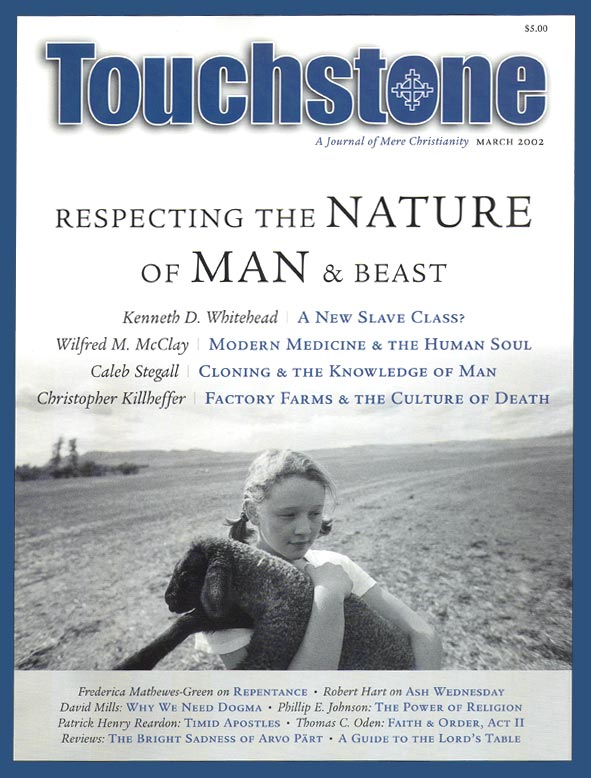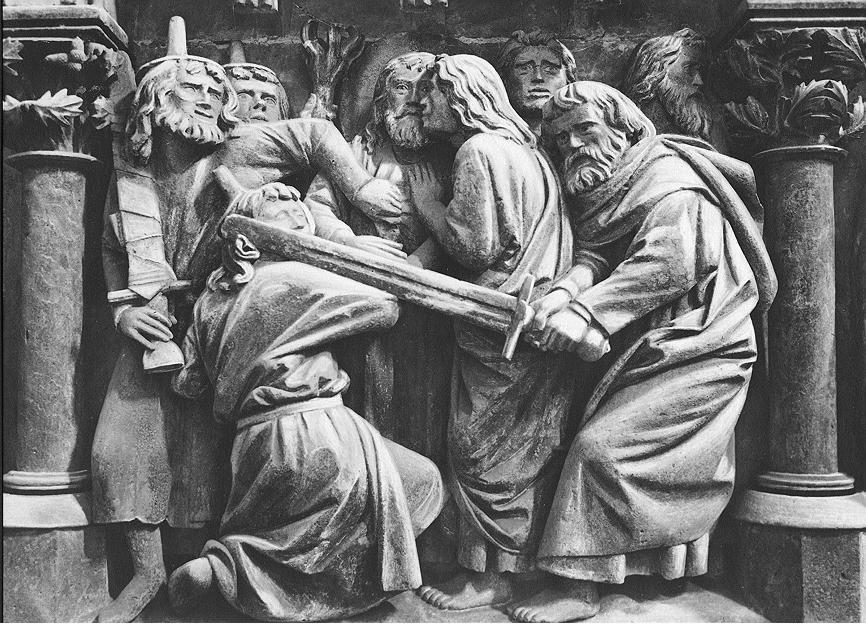Sliding Towards Slavery
The President’s Stem-Cell Decision Leaves Us on a Slippery Slope
by Kenneth D. Whitehead
We are now well into the still uncharted new world that has followed the terrorist attacks on the United States on September 11, 2001, yet the temptation remains great to put aside other concerns “for the duration,” as used to be said during World War II. The trouble is, as most informed observers agree, that the murky kind of war we are now engaged in is likely to be with us for some time; it does not seem likely that we will soon—or ever—simply return to what we once understood as “normal times.”
Precisely for this reason the temptation is also great to try to spare from criticism leaders who henceforth are obliged to make life-and-death decisions. Nevertheless, the fact that our national mobilization for today’s new kind of warfare is going to be indefinite means that we must also go on dealing with other issues that affect our lives as well—for some of them are life-and-death decisions, too.
A Pro-Life Line?
A case in point is the decision made by President George W. Bush on August 9, 2001, to allow federal funding for limited embryonic stem-cell research. This decision created quite a stir at the time, though it has been largely lost from sight since then. By deciding to provide federal support for research on already existing stem-cell lines derived from embryos created in in-vitro fertilization (IVF) clinics, while excluding the creation and destruction of additional embryos in order to extract their stem cells, the president appeared to believe that he was making a proper, responsible, and ethical decision. As he said in his nationally televised address announcing the decision—a speech that was widely praised by some pro-lifers since it represented the first time a president had ever articulated a pro-life position in a speech before a national audience—President Bush declared that it “allows us to explore the promise and potential of stem-cell research without crossing a fundamental moral line that would sanction or encourage further destruction of human embryos that have at least a potential for life.”
The president thus clearly recognized that a “fundamental moral line” exists and can be crossed, and he plainly said that he did not want to cross it. Whether or not he has crossed it is a question that must be looked at.
In a subsequent interview on ABC News, the president went further. He stated that he believes that human life begins at conception. “Even in a petri dish? Even with a few cells?” his interviewer asked him. “Yes, yes, I believe that,” the president replied. “And that influenced my decision, of course,” he added. Thus, according to him, embryos have more than just a “potential for life”; they are human life. And the president appeared to believe sincerely that his decision provided proper safeguards for respecting and protecting this nascent human life.
President Bush also stated clearly in his televised address that “even the most noble ends do not justify any means.” In a subsequent op-ed article in the New York Times defending and justifying his decision, he put the whole thing bluntly: “We do not end some lives for the medical benefit of others.”
Thus, the president came across on stem-cell research as a responsible, thoughtful, and moral man. He was widely praised for the moral seriousness with which he arrived at and announced his decision. Even many (but not all) pro-life voices and organizations seemed, at least initially, to go along with the president, pointing to his unwillingness to sacrifice additional embryos, while downplaying his willingness to make use of the products of embryos sacrificed earlier.
The American Catholic bishops seemed to be the most significant voices fairly consistently opposed to the president’s decision. In addition to a statement from the president of the bishops’ conference declaring that the president’s “compromise” solution was “morally unacceptable,” more than a dozen bishops issued their own statements, all of which found the president’s decision to be the wrong one (although, like many pro-life voices and organizations, some of the bishops were anxious to give the president some credit for his declared “pro-life” position against allowing the destruction of any further embryos).
Did the Catholic bishops see something that so many others apparently did not? Did the fairly widespread tendency to approve and even applaud the president’s decision indicate that perhaps not many people were looking closely at exactly what the president had decided?
A Wrong Decision
In fact, for some of us, the praise about how morally and thoughtfully and responsibly the president proceeded simply made more perplexing and, indeed, quite dismaying the conclusion President Bush arrived at. For the president’s decision is not only wrong; it is fundamentally, even catastrophically, wrong. And its ultimate negative consequences for the pro-life cause may be very far-reaching indeed. While the president sincerely maintained that he respects human life, the actual decision he made does not respect it.
No matter how he and his advisors and supporters may have attempted to put a different construction upon it, the president’s decision goes against his well publicized campaign pledge that “taxpayer funds should not be used to underwrite research that involves the destruction of live human embryos.” The president flip-flopped: The research he decided to authorize does “involve” the use of stem-cell lines produced in no other way than by the deliberate destruction of human embryos. There is no way that the use he is now allowing can be described as non-involvement.
The president justified this use, of course. In his address to the nation he did this by stating that “the life-and-death decision has already been made.” The government was not involved in the decision to destroy the embryos from which the existing stem-cell lines were derived. The president was simply proposing to make good use of the products of these past (though presumably evil) deeds. In his Times op-ed article, he provided further justification for his position by noting that the only live chicken-pox vaccine currently used in the United States was developed in part from research involving human embryos that had been developed into cell lines. Yet, he pointed out, most people see no moral problem in making use of this chicken-pox vaccine.
The analogy is not exact, however. No human life was destroyed with the intention, or for the purpose, of providing material from which to develop vaccine. Furthermore, many of those who have made use of or have benefited from the vaccine that was developed were unaware of how it was developed—that is, by using what the president admitted were unethical and immoral means.
Now, however, what the president has proposed with his stem-cell decision is that we should henceforth, in effect, institutionalize the derivation of medical remedies and cures from admittedly immoral earlier procedures. We know very well how the stem-cell lines to be used for research were obtained. By agreeing to use them, we accept and condone the unethical and immoral actions of those who obtained them. The only moral distance or separation we have from these earlier immoral means is one of time, a temporal separation; the benefit we seek is still being derived directly from admittedly immoral means.
No Moral Ground
The morality of such a position is surely highly questionable at best, and scarcely befits anyone attempting to take the moral high ground, which the president appears to want to do. Yet he plainly stated his very questionable principle in his Times op-ed article: “While it is unethical to end life in medical research,” he wrote, “it is ethical to benefit from research where life-and-death decisions have already been made.”
If the president seriously intends this latter statement as an unqualified statement of principle, it is going to be impossible to maintain his ban on any further destruction of embryos for the purpose of extracting their stem cells. All that will be required to get around the ban is to make sure that “the life-and-death decisions” regarding future embryos to be destroyed to create new stem-cell lines be made in, say, private IVF fertility clinics (as at present) rather than in federally funded laboratories. That would be the only limitation, on the president’s own announced principle, on accepting new stem-cell lines after the life-and-death decisions to create them have already been taken and acted upon elsewhere than in federally supported facilities. The president has not left himself any principled basis on which to object to further research on newly created stem-cell lines once they have been brought into existence by the private decisions of others.
President Bush and members of his administration, such as HHS Secretary Tommy Thompson and White House Chief of Staff Andrew Card, have nevertheless adamantly insisted that “this president” will not countenance any further destruction of embryos. Unfortunately, however, the only ground the president has to stand on here is his own bare assertion that he will not—the assertion of someone who asserted during the campaign that taxpayer funds should not be used for research involving the destruction of embryos but then went on to justify such use for this kind of research.
For the president has now granted in principle that embryos earlier destroyed by others can subsequently be utilized in federally funded research for the good purpose of seeking cures for diseases. This position is indistinguishable from what the Clinton administration also permitted—contrary to existing federal law prohibiting experimentation on embryos—in its disgraceful, jerry-built regulations allowing federal researchers to work on embryonic stem cells provided they were obtained from non-federal sources.
Also, nobody in the Bush administration has explained how the president’s decision gets around the 1994 Congressional prohibition against federal funding of procedures involving the destruction of embryos; the president’s decision, apparently, is against the law, although nobody seems to have addressed this question in the course of the discussions concerning his decision.
In describing where he thinks we are on this issue, the president resorted to a curious usage in his Times op-ed article. “Stem-cell research,” he wrote, “takes place on a slippery slope of moral concern where much biomedical research is and will be conducted. We must keep our ethical footing. . . .”
It would appear that President Bush sees the famous “slippery slope” as a place where we can and should venture provided only that we “keep our ethical footing.” This is a very unusual and revealing usage. The usual meaning of the phrase, of course, is that the slippery slope is a place where, by definition, we can no longer maintain any footing at all, but rather are subject to and being carried along down the slope by forces beyond our control. Normally the phrase is used to describe a place we absolutely have to avoid.
The president’s use of the phrase is thus highly significant, for in his embryonic stem-cell decision, he claims to be able to maintain a ban on any further destruction of embryos at the same time as he agrees that research involving stem cells extracted from embryos destroyed earlier is legitimate and permissible, at least under some circumstances (when the “life-and-death decision has already been made”). Any time these decisions are made by others in spite of his ban, however, he has left himself without any rational basis to forbid the use of the stem cells.
Moreover, by the legitimacy he has already granted with his decision to approve this type of research, he cannot not “encourage further destruction of embryos,” contrary to his own words. For he has now officially declared that embryonic stem-cell research, as such, is legitimate and desirable in the eyes of the government, and so it should not surprise anyone if scientists are now found to be very much “encouraged” at being able to pursue it vigorously, with the only condition being that the destruction of embryos not be federally funded.
Thus, the president’s carefully constructed “compromise” solution to the embryonic stem-cell research dilemma is a highly artificial and unstable one. It is quite unlikely to hold up for very long. The pressures from researchers and their supporters to expand it and even to effectively abolish it—pressures that proved only too effective in persuading the president to go as far as he did after having come out entirely against stem-cell research during the campaign—these pressures to break down his already compromised decision began virtually the moment the president finished speaking and have not abated, if we may judge from the ongoing saga of the stem-cell discussion as presented in the media.
The Irresistible Slide
Barely a month passed, for example, before the prestigious National Academy of Sciences came out with a blue-ribbon report claiming that the stem-cell research to be conducted with federal support would not live up to its expected therapeutic potential if the work continued to be restricted to the small number of cell lines from the “limited number of embryos” the president agreed could be used. The pressure from the scientific establishment and its allies in Congress and elsewhere to expand the number of available cell lines will surely be unrelenting. Researchers in this prestigious new field will not be satisfied until they have their own embryo farms or colonies, just as the IVF clinics already do.
The proponents of embryonic stem-cell research understand very well that the president has opened up a new door. The only question for them, as Senator Ted Kennedy expressed it at a congressional hearing, is whether the door is open “wide enough.” Given the pressures, it is only going to be a matter of time before it gets pushed open further. As the Washington Post expressed it in an editorial, “Mr. Bush’s policy will prove a critical first step in legitimizing this research” (emphasis added).
Yes, that is exactly what the president’s decision amounts to: “a critical first step in legitimizing” embryonic stem-cell research. The president has opened a new door with his decision, a door that neither he nor any of his successors is going to be able to close without reexamining the basic principles involved and without a firm recommitment to the principle that no just society can allow the elective killing of others for any purpose. By effectively abandoning that principle and tacitly agreeing that “life-and-death decisions” made by others are henceforth allowable, the president has put us squarely on that famous slippery slope. As we slide inexorably down, we are going to discover, sooner or later—and probably sooner—that there is no chance of regaining an ethical foothold unless and until the president’s decision is reversed and research involving the destruction of human embryos is flatly banned.
The National Academy of Sciences report, for example, after calling for additional stem-cell lines from newly destroyed embryos, went on to say that scientists must also be allowed to pursue research that involves the cloning of human embryos. The cells that can be derived from cloned embryos, it is stated, will prove especially useful for the treatment of many degenerative conditions—while, once again, it has already been granted that the existence of such degenerative conditions justifies this kind of research. The president has tried to draw a line that is simply not going to hold.
This was dramatically shown at the end of November when the Advanced Cell Technology Company in Worcester, Massachusetts, announced that it had successfully cloned human embryos in order to extract their stem cells. Not surprisingly, President Bush promptly declared that he wanted a total ban on cloning; he declared that it was “morally wrong”; and no doubt he sincerely believes this. His sentiments were echoed by some members of Congress; indeed, the House has already passed a total ban on human cloning.
On the Senate side, however, a number of influential senators made clear that while they might vote to ban “reproductive cloning”—cloning designed to produce a baby—they favored allowing “therapeutic cloning,” that is, cloning to produce embryos for the extraction of their stem cells—exactly what the Massachusetts company produced, and exactly what the president’s embryonic stem-cell decision, unfortunately, allows in principle (after all, no federal funds were involved in this “private” life-and-death decision). The prospects in the US Senate for the ban on human cloning that the president has called for thus do not seem auspicious at present, and the president’s own embryonic stem-cell research decision has contributed greatly to the climate in which senators now dare to propose doing research involving embryos created for that purpose.
Evil Nonetheless
President Bush’s mistake in this case is a common one: People think they can arbitrarily draw moral lines where they want them. They fail to understand that the logic of their decision is going to work itself out regardless of the lines they attempt to draw. Once America decided with Roe v. Wade, for example, that we can legitimately take by abortion the lives we do not want, then we are no longer able to draw a line forbidding the taking of yet other lives we do not want, e.g., by euthanasia—or by using embryos from IVF clinics that “are going to be discarded anyway.” (We have not even touched upon the monstrous irony and evil of regularly producing live human embryos—many of which are indeed slated to be “discarded”—by the thousands in our virtually unregulated IVF industry—with no apparent protests from anybody. Certainly there are few or no politicians, from the president on down, who dare to open that can of worms; nor do many pro-life voices or organizations appear ready to face squarely what is going on unimpeded in IVF clinics today.)
The principle at work in all this, apparently, is that we are going to find a way to justify what we want to do (think we have to do), and the logic of this has been working itself out in our society over the past 30 years since Roe v. Wade. In one sense, the slippery slope is nothing more than the working out of the logic of premises earlier adopted.
By agreeing in principle that the products of destroyed human embryos can be legitimately funded with taxpayer dollars under some circumstances, the president has left open only the question: under what circumstances? Meanwhile, he has breached a principle, upheld until now by civilized people and most responsible ethicists, namely, that the utilitarian use of, or experimentation upon, human beings is neither legitimate nor ethical, even for the good and laudable purpose of helping others. The president himself states and approves this principle, but the decision he has made violates it. Even while he says that the end does not justify the means, this is precisely what is inherent in the decision he has made: The end of possibly being able to cure diseases is made to justify the previously forbidden means of using human beings as objects on which to conduct experiments.
To be sure, experimentation upon human beings is not the same wrong as killing them, but it is as gravely wrong as, for example, enslaving them: In both cases they are being treated as objects. While slavery is almost universally condemned today, we are meanwhile establishing something very like slavery, where the “enslaved” class consists of the embryos produced in IVF clinics—and no doubt soon to be produced in embryonic stem-cell research laboratories as well.
Embryos having become mere “objects,” it is difficult to see how we are going to be able to hold out against cloning. The National Academy of Sciences report understands this perfectly; so does the Advanced Cell Technology Company in Massachusetts; so do a number of influential senators. Only those pro-life voices and organizations that approved of the president’s August decision seem not to understand it. The logic is there: If these embryos are mere objects, what objection can there be to experimenting upon them, even to cloning them?
But if they are not mere objects, how can they be artificially created and then destroyed for their stem cells? How can the stem cells derived from them be ethically used, however praiseworthy the cause, especially considering that the embryos had to be intentionally destroyed to extract them? This is a clear case of what Catholic theology calls illicit material cooperation with evil. Perhaps it is more than material cooperation; perhaps it is formal cooperation with evil, intentionally done.
Again, it may not be the same evil as the actual destruction of embryos, but it is evil nonetheless. And it is fraught with severe consequences for the pro-life movement’s attempt to restore respect and legal protection for human life at all stages of its development.
The sad fact is that President George W. Bush, whether he realizes it or not, has already crossed that fundamental moral line that he spoke about. We are on our way down that slippery slope. By his decision to allow stem cells taken from destroyed human embryos to be used for experimentation, what he claims to believe is a human being can now be legitimately treated as a means and not as an end. This is not merely contrary to Catholic teaching; Immanuel Kant, among others, would surely never have approved.
And the saddest fact of all is that it has been our professed “pro-life” president who has led us across this threshold—with the support and approval of important pro-life voices and organizations. Who would ever have imagined that such a wound could be inflicted upon the pro-life movement by “friendly fire”?
Kenneth D. Whitehead is the 2004 recipient of the Blessed Frederic Ozanam Award for Catholic Social Action of the Society of Catholic Social Scientists (SCSS). He writes frequently on Catholic social and moral issues.
subscription options
Order
Print/Online Subscription

Get six issues (one year) of Touchstone PLUS full online access including pdf downloads for only $39.95. That's only $3.34 per month!
Order
Online Only
Subscription

Get a one-year full-access subscription to the Touchstone online archives for only $19.95. That's only $1.66 per month!
bulk subscriptions
Order Touchstone subscriptions in bulk and save $10 per sub! Each subscription includes 6 issues of Touchstone plus full online access to touchstonemag.com—including archives, videos, and pdf downloads of recent issues for only $29.95 each! Great for churches or study groups.
Transactions will be processed on a secure server.
more from the online archives
calling all readers
Please Donate
"There are magazines worth reading but few worth saving . . . Touchstone is just such a magazine."
—Alice von Hildebrand
"Here we do not concede one square millimeter of territory to falsehood, folly, contemporary sentimentality, or fashion. We speak the truth, and let God be our judge. . . . Touchstone is the one committedly Christian conservative journal."
—Anthony Esolen, Touchstone senior editor









